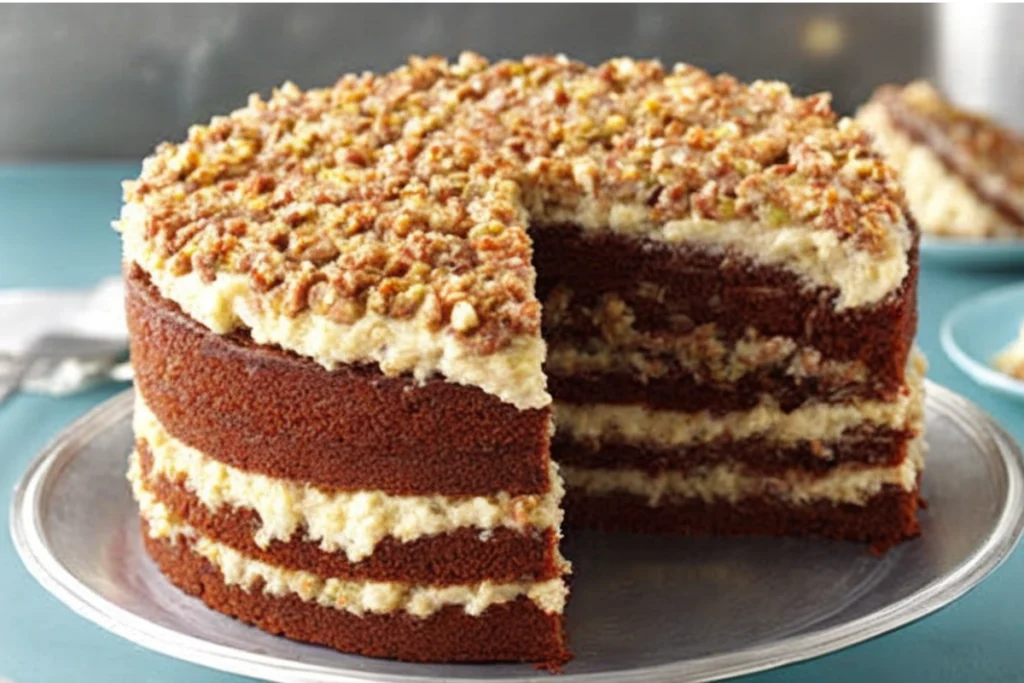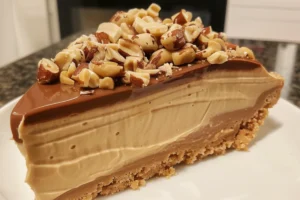Baker’s German Chocolate Cake is a dessert that has stood the test of time. This rich, moist cake is a staple in American baking, known for its unique flavor, thanks to the Baker’s German sweet chocolate and the decadent coconut-pecan frosting. Whether you’re a seasoned baker or a beginner, this cake is a must-try for anyone who loves chocolate. In this article, we’ll guide you through the entire process, from selecting the best ingredients to perfecting the final presentation.
The Origin of Baker’s German Chocolate Cake
The story behind ( German Chocolate Cake )this iconic cake is as fascinating as its taste. Despite its name, Baker’s German Chocolate Cake isn’t German at all. The recipe dates back to 1957, when a Texas homemaker, Mrs. George Clay, submitted it to a Dallas newspaper. The cake was named after Samuel German, who created the mild dark baking chocolate for the Baker’s Chocolate Company in 1852. This cake quickly gained popularity and became a beloved dessert across the United States.
For a deeper understanding of this cake’s history, you can check out the History of German Chocolate Cake for more context on how it became an American classic.
Ingredients Overview
Before diving into the baking process, let’s take a closer look at the essential ingredients needed for this recipe. The quality of your ingredients plays a crucial role in the final outcome of your cake.
Essential Ingredients:
- Baker’s German Sweet Chocolate: This mild dark chocolate is the star ingredient. It’s essential for achieving the authentic flavor of the cake.
- Butter or Margarine: Provides richness and moisture to the cake layers.
- Granulated Sugar: The sweetness balances the dark chocolate.
- Eggs: Essential for structure and moisture.
- All-Purpose Flour: The base of the cake, providing the necessary structure.
- Buttermilk: Adds moisture and a slight tang, enhancing the cake’s flavor.
- Coconut and Pecans: Key ingredients for the traditional frosting.
For those who may not have Baker’s German sweet chocolate on hand, there are alternatives. You can learn about potential substitutes at Substitutes for German Sweet Chocolate.
Step-by-Step Preparation Guide
Baking Baker’s German Chocolate Cake is a process that requires precision, but the results are well worth the effort. Follow this step-by-step guide to ensure your cake turns out perfectly.
1. Melting the Chocolate
Start by melting your Baker’s German sweet chocolate in boiling water. Ensure the chocolate is fully melted and smooth before setting it aside to cool. This step is crucial as it helps to blend the chocolate seamlessly into the batter.
2. Creaming the Butter and Sugar
In a large mixing bowl, cream the butter and sugar together until light and fluffy. This process incorporates air into the mixture, which helps create a light and tender cake. Make sure your butter is at room temperature to achieve the best results.
3. Mixing the Dry Ingredients
In a separate bowl, sift together the flour, baking soda, and salt. Sifting not only removes any lumps but also ensures that the ingredients are evenly distributed. This step is vital for achieving a consistent texture throughout the cake.
4. Combining Wet and Dry Ingredients
Alternate adding the dry ingredients and buttermilk to the butter mixture, starting and ending with the dry ingredients. Mix until just combined to avoid overbeating, which can make the cake dense.
5. Beating and Folding Egg Whites
In a clean bowl, beat the egg whites until stiff peaks form. Gently fold the egg whites into the batter, being careful not to deflate them. This step is essential for achieving a light, airy texture in the cake.
6. Baking the Cake Layers
Preheat your oven to 350°F (175°C). Pour the batter into three 9-inch round cake pans lined with wax paper. Bake for 30 minutes or until a toothpick inserted into the center comes out clean. The cake layers should spring back when lightly pressed.
7. Cooling the Cake
Once baked, allow the cake layers to cool in the pans for 10 minutes before removing them to a wire rack. Let the layers cool completely before frosting to prevent the frosting from melting.
Coconut-Pecan Frosting Preparation
The coconut-pecan frosting is what truly sets this cake apart. Rich, creamy, and full of texture, this frosting is as delicious as it is unique.
1. Ingredients for Frosting
- Evaporated Milk: Adds creaminess to the frosting.
- Granulated Sugar: Sweetens the frosting.
- Egg Yolks: Thicken the mixture and add richness.
- Butter or Margarine: Adds smoothness and flavor.
- Shredded Coconut: Provides texture and a subtle sweetness.
- Chopped Pecans: Adds crunch and depth of flavor.
2. Cooking the Frosting
Combine the evaporated milk, sugar, egg yolks, and butter in a saucepan. Cook over medium heat, stirring constantly until the mixture thickens. This usually takes about 12 minutes. The consistency should be thick enough to coat the back of a spoon.
3. Adding Coconut and Pecans
Once the mixture has thickened, remove it from the heat and stir in the shredded coconut and chopped pecans. Let the frosting cool until it reaches a spreadable consistency.
4. Cooling the Frosting
Allow the frosting to cool completely before using it. For best results, refrigerate the frosting for a few hours or overnight to let it firm up, making it easier to spread.
Assembling the Cake
Now that your cake layers and frosting are ready, it’s time to assemble the cake. This step requires a bit of patience, but the end result is a beautifully layered cake that’s sure to impress.
1. Layering the Cake
Start by placing the first cake layer on a serving plate. Spread a generous amount of frosting over the top, ensuring it’s evenly distributed. Repeat this process with the second and third layers.
2. Frosting the Cake
Once all the layers are stacked, spread the remaining frosting over the top and sides of the cake. Use a spatula to smooth the frosting, ensuring an even coating.
3. Finishing Touches
For an added touch, you can garnish the cake with additional coconut and pecans. This not only enhances the presentation but also adds extra flavor and texture.
Tips and Variations
To make the most out of your Baker’s German Chocolate Cake, here are some tips and variations you can try.
1. Substitutions for Ingredients
- If you can’t find Baker’s German sweet chocolate, you can substitute it with a combination of semi-sweet chocolate and a small amount of sugar.
- For a dairy-free version, use vegan butter and coconut milk instead of evaporated milk.
2. Making a Sheet Cake Version
If you prefer a sheet cake over a layered one, simply pour the batter into a 9×13 inch pan and bake at 350°F (175°C) for 40-45 minutes. This version is easier to serve and just as delicious.
3. Adding Flavors
To add a twist to the traditional recipe, consider incorporating espresso powder into the batter for a mocha flavor. You can also experiment with different nuts, like walnuts or almonds, in the frosting.
4. Healthier Variations
For a healthier version of this cake, reduce the sugar by 25% and use whole wheat flour instead of all-purpose flour. You can also substitute half of the butter with applesauce to cut down on fat without sacrificing moisture.
Frequently Asked Questions (FAQs)
As with any classic recipe, there are often questions about how to get the best results, make substitutions, or adapt the recipe to specific needs. Here are some of the most frequently asked questions about Baker’s German Chocolate Cake.
1. Can I Use Unsweetened Chocolate Instead of Baker’s German Sweet Chocolate?
While it’s possible to use unsweetened chocolate, the flavor and texture of the cake will be different. Baker’s German sweet chocolate contains sugar and has a milder flavor, which is crucial for the cake’s distinctive taste. If you must use unsweetened chocolate, you’ll need to add additional sugar to the recipe to balance the bitterness.
2. How Do I Prevent the Cake from Drying Out?
To keep your cake moist, make sure not to overbake it. Start checking for doneness a few minutes before the recommended baking time. Additionally, using buttermilk in the recipe helps maintain moisture. After baking, you can brush the cake layers with a simple syrup before frosting to add extra moisture.
3. What Can I Use as a Substitute If I Don’t Have Buttermilk?
If you don’t have buttermilk on hand, you can make a substitute by adding 1 tablespoon of lemon juice or vinegar to 1 cup of milk. Let it sit for 5-10 minutes before using it in the recipe. This mixture will mimic the acidity and texture of buttermilk.
4. Can This Cake Be Made in Advance?
Yes, Baker’s German Chocolate Cake can be made in advance. You can bake the cake layers and prepare the frosting a day or two ahead of time. Store the cake layers tightly wrapped in plastic wrap at room temperature, and refrigerate the frosting. Assemble the cake on the day you plan to serve it.
5. Why Did Baker’s Stop Printing the Original Recipe on the Box?
Baker’s stopped printing the original recipe on their chocolate packaging to make space for new marketing materials and updates. However, the recipe remains a beloved classic, and it’s widely available online and in many cookbooks.
6. How Can I Convert This Recipe for High-Altitude Baking?
High-altitude baking requires some adjustments to prevent the cake from collapsing or drying out. Generally, you’ll want to decrease the baking powder or baking soda slightly and increase the liquid (such as buttermilk) to compensate for the drier environment. Reducing the sugar by a tablespoon or two can also help. Baking times may need to be reduced, so start checking for doneness earlier than the recipe suggests.
Conclusion
Baking Baker’s German Chocolate Cake is not just about following a recipe; it’s about creating a rich, moist, and decadent dessert that has been a part of American traditions for decades. Whether you’re baking it for a special occasion or just because you’re craving something sweet, this cake is sure to impress.
Remember, the key to success is in the details – from selecting the right ingredients to following each step carefully. And with the tips and variations provided, you can customize the cake to suit your tastes and dietary needs.
So why not try making this classic cake at home? Not only will you enjoy the process, but you’ll also create a dessert that’s truly unforgettable.




